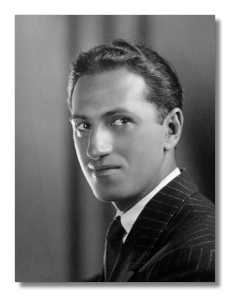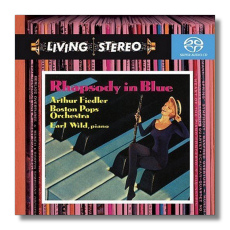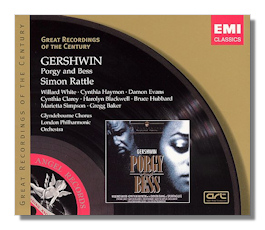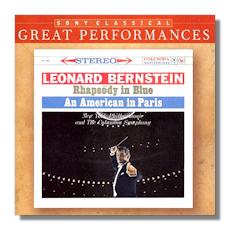
The Internet's Premier Classical Music Source
Related Links
- Recommended Recordings
Recommended Biographies
CD / DVD Reviews - Gershwin Biography
- Gershwin - The Early Years
- Schoenberg on Gershwin
- Rhapsody in Blue
Listener's Guide
-
Find CDs & Downloads
Amazon - UK - Germany - Canada - France - Japan
ArkivMusic - CD Universe
Find DVDs & Blu-ray
Amazon - UK - Germany - Canada - France - Japan
ArkivMusic-Video Universe
Find Scores & Sheet Music
Sheet Music Plus -
- George and Ira Gershwin Educational Fanpage
- George Gershwin,
The Spanish Page
by Oscar Vallejo - George Gershwin Alone
by Hershey Felder - 1935 Stage Magazine Review of Porgy & Bess
Recommended Links
Site News
George Gershwin

(1898 - 1937)
This American composer had a foot in two camps: pop music and concert music. He innovated in both, writing songs and Broadway musicals which not only define the 20s and 30s (especially Oh, Kay!, Girl Crazy, and Lady Be Good) but break paths which would be fully exploited only later (Strike Up the Band, Of Thee I Sing, and Let 'Em Eat Cake) with the Rodgers and Hammerstein "book" musicals of the 40s. For the concert hall, he invented a distinctive and immediately identifiable idiom with the poetically-named Rhapsody in Blue (1924) and Piano Concerto in F (1925). Almost every one of his concert works has entered the repertory, and, just as important, the American psyche. In that regard, he is the American equivalent of Verdi. People with no interest in opera hum parts of his Porgy and Bess (1935) without knowing where the material comes from or even that it's part of something larger.
He showed an absolute passion to improve his work. He managed to travel a great artistic distance from the relatively simple tunes of Rhapsody in Blue to the great formal resource of American in Paris (1928), Cuban Overture (1932), and many scenes in Porgy and Bess.
Much has been made of his debt to African-American music, and it is indeed a major source of his inspiration, but it's not the only one. Igor Stravinsky, Claude Debussy, Piotr Tchaikovsky, and even Jewish chant also contribute to his (paradoxically) quite original music. Those who would learn from him have to be careful not to wind up "doing" Gershwin.
His critical reputation has suffered among American critics trying to find and nurture a "serious" native style. Even now, his works usually appear on Pops programs, rather than during the regular season, and it has long been the fashion for critics to patronize the music. A really good, committed performance is hard to come by, although one can detect serious interest beginning to be directed toward the musicals and concert works. Europeans, unencumbered by distinctions of "high" and "low" art, have long considered him one of the century's great song writers. His fans included Arnold Schoenberg, Maurice Ravel (who modeled both his mature violin sonata and his Piano Concerto in G on Gershwin's idiom), and Francis Poulenc.
True junk has a short shelf life. Gershwin's works remain fresh and ravishing after 70 years. ~Steve Schwartz

Recommended Recordings
American in Paris
- Tone Poem "An American In Paris", Cuban Overture, Variations on "I Got Rhythm", Concerto in F, Rhapsody in Blue/RCA Red Seal Hybrid Multichannel SACD 82876-61393-2
-
Arthur Fiedler/Boston Pops
- Tone Poem "An American In Paris", Rhapsody in Blue, Concerto in F/EMI CDC747161-2
-
André Previn/London Symphony Orchestra
- Tone Poem "An American In Paris", Concerto in F, Rhapsody in Blue/Sony 78768
-
Leonard Bernstein/New York Philharmonic Orchestra
- Tone Poem "An American In Paris", Cuban Overture, Porgy & Bess Symphonic Picture/RCA Victrola 7726-2-RV
-
Eduardo Mata/Dallas Symphony Orchestra
Piano Music (including Variations on "I Got Rhythm")
- Improvisations on "Fascinating Rhythm", "I Got Rhythm", "Rialto Ripples", "Someone To Watch Over Me", "'S Wonderful", etc./Stradivari Classics SCD-6039
-
Paul Posnak (piano)
- Introduction, Theme & Variations on "I Got Rhythm", Rhapsody in Blue & "An American In Paris"/Pro Arte CDD367
-
James Anagnoson & Leslie Kinton (pianos)
Porgy & Bess (opera - selections - symphonic picture)
- Porgy & Bess/EMI Great Recordings of the Century 76832-2
-
Willard White (bass), Cynthia Haymon (soprano), Damon Evans (tenor), Cynthia Clarey (soprano), Harolyn Blackwell (soprano), Bruce Hubbard (baritone), Marietta Simpson (mezzo soprano), Gregg Baker (baritone), Simon Rattle/London Philharmonic Orchestra, Glyndebourne Festival Chorus
- Porgy & Bess/London-Decca 475787-7
- Alvy Powell (bass baritone), Marquita Lister (soprano), Robert Mack (tenor), Nicole Cabell (soprano), Uzee Brown (baritone), Tiffany Nicole Wharton (mezzo soprano), Justin Lee Miller (baritone), John Mauceri/Nashville Symphony Orchestra & Chorus, Blair Children's Chorus members
- Symphonic Picture "Porgy & Bess" w/ Grofé/London 410110-2 reissued on London/Decca Jubilee 430712-2
-
Antál Doráti/Detroit Symphony Orchestra
- Symphonic Picture "Porgy & Bess"/RCA Victrola 7726-2-RV
-
Eduardo Mata/Dallas Symphony Orchestra
 Rhapsody in Blue
Rhapsody in Blue
- Rhapsody in Blue, Concerto in F, An American In Paris/Sony 78768
-
Leonard Bernstein (piano), Leonard Bernstein/Columbia Symphony Orchestra
- Rhapsody in Blue & 3 Preludes for Piano/CBS MK39699
-
Michael Tilson Thomas (piano), Michael Tilson Thomas/Los Angeles Philharmonic Orchestra
- Rhapsody in Blue, Cuban Overture, Variations on "I Got Rhythm", Concerto in F, An American In Paris/RCA Red Seal Hybrid Multichannel SACD 82876-61393-2
-
Earl Wild (piano), Arthur Fiedler/Boston Pops
- Rhapsody in Blue w/ Addinsell, Chopin, Litolff, Liszt/Philips 411123-2
-
Misha Dichter (piano), Neville Marriner/Philharmonia Orchestra
- Rhapsody in Blue (solo Piano Version)/Special Music SCD-8000
-
Norman Krieger (piano)
- Rhapsody in Blue (two-Piano Version)/Pro Arte CDD367
-
James Anagnoson & Leslie Kinton (pianos)
















